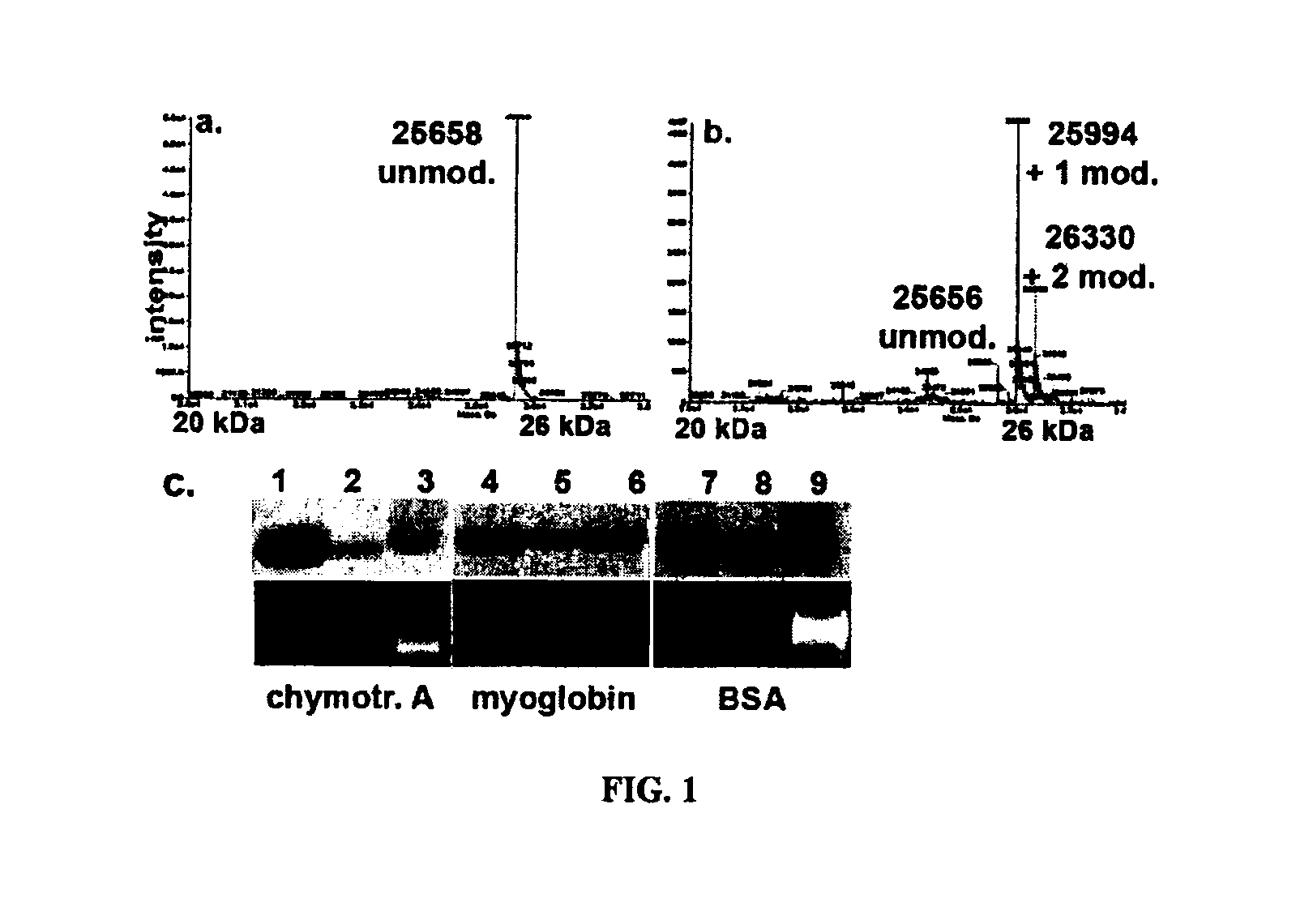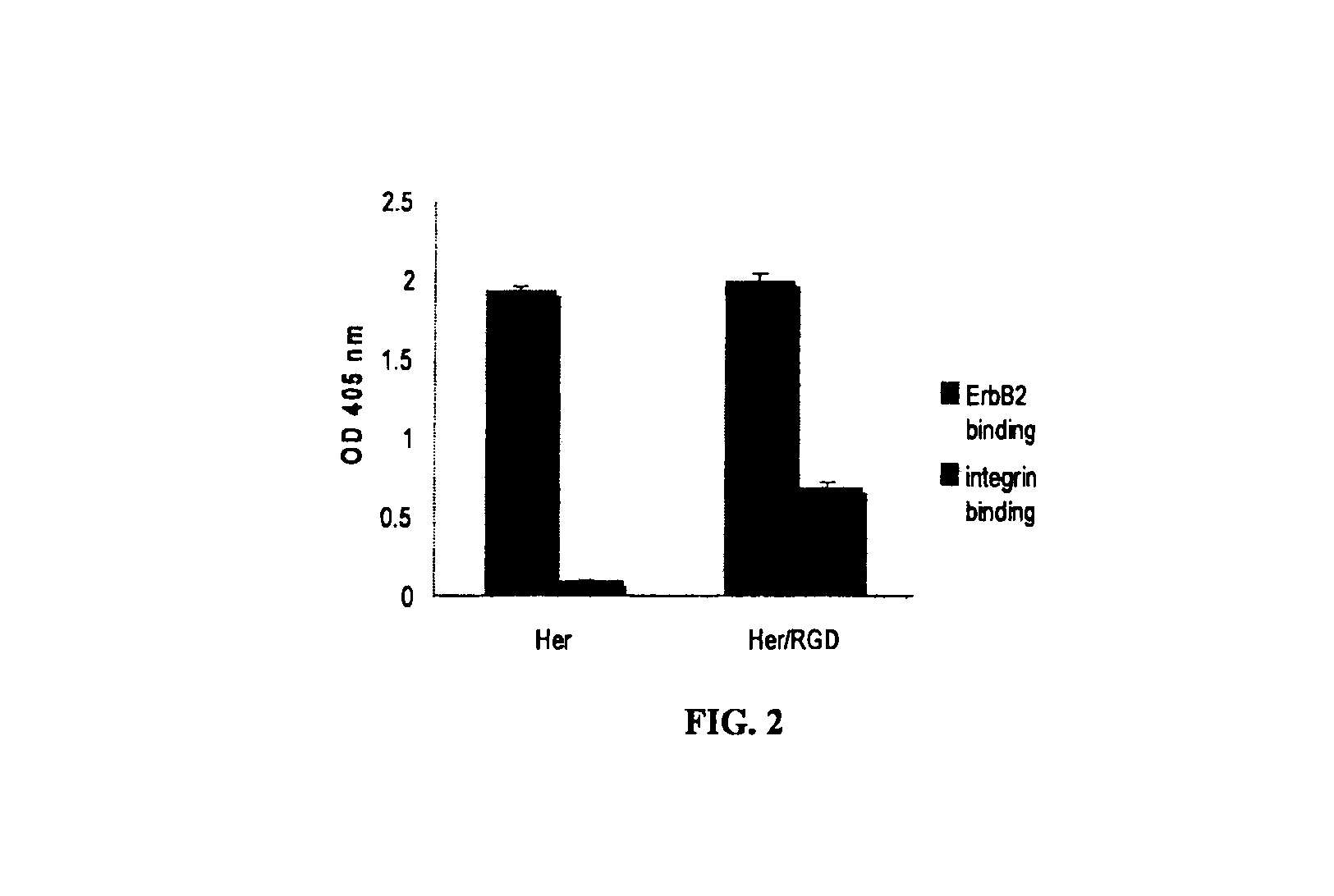Tyrosine bioconjugation through aqueous Ene-like reactions
a technology of tyrosine residues and bioconjugation, which is applied in the field of bioconjugation of proteins, can solve problems such as challenging site-specific modification, and achieve the effect of convenient preparation
- Summary
- Abstract
- Description
- Claims
- Application Information
AI Technical Summary
Benefits of technology
Problems solved by technology
Method used
Image
Examples
example 1
Coupling of N-acyl tyrosine methylamide 1 with PTAD 2
[0405]
[0406]To a solution of N-acyl tyrosine methylamide 1 (14.2 mg, 0.060 mmol) in 100 mM pH 7.0 NaH2PO4 / Na2HPO4 buffer (1.5 mL)-CH3CN (1.5 mL) was added the 0.5 M solution of PTAD 2 (0.132 mL, 0.066 mmol) in CH3CN at room temperature. The resulting solution was stirred at room temperature for 30 minutes. The reaction mixture was acidified with 12N HCl (0.249 mL) and concentrated in vacuo. The obtained crude material was purified by flash column chromatography (CHCl3 / CH3OH) to give 3 (16.0 mg, 65%) as a white solid. 1H NMR (300 MHz, DMSO-d6): δ 11.57 (br, 1H), 8.06 (d, J=8.4 Hz, 1H), 7.90 (q, J=4.3 Hz, 1H), 7.74 (d, J=1.7 Hz, 1H), 7.63-7.51 (m, 2H), 7.43 (t, J=7.8 Hz, 2H), 7.34-7.21 (m, 1H), 6.83 (dd, J=8.2, 2.0 Hz, 1H), 6.68 (d, J=8.2 Hz, 1H), 4.33 (m, 1H), 2.85 (dd, J=13.5, 5.1 Hz, 1H), 2.63 (dd, J=13.7, 9.2 Hz, 1H), 2.55 (d, J=4.5 Hz, 3H), 1.78 (s, 3H). 13C NMR (150 MHz, DMSO-d6): δ 172.64, 170.02, 153.90, 150.86, 148.44, 135....
example 2
Coupling of H-Gly-Gly-Tyr-OH 4 with PTAD 2
[0407]
[0408]A 0.1M solution of PTAD 2 (1.00 mL, 0.100 mmol) in CH3CN was added (0.200 mL×5 times, interval 1 minute) into a solution of H-Gly-Gly-Tyr-OH 4 (11.8 mg, 0.040 mmol) in 200 mM pH 7.0 NaH2PO4 / Na2HPO4 buffer (1.0 mL)-CH3CN (1.0 mL) at room temperature. The resulting solution was stirred at room temperature for 30 minutes. The reaction mixture was acidified with 12N HCl (0.166 mL) and then concentrated in vacuo. The obtained crude material was purified by reversed phase HPLC to give 5 (19.8 mg, 85%) as amorphous solid. 1H NMR (300 MHz, D2O): δ 7.66-7.42 (m, 5H), 7.31 (d, J=2.1 Hz, 1H), 7.26 (dd, J=8.4, 2.2 Hz, 1H), 7.03 (d, J=8.4 Hz, 1H), 4.58 (dd, J=8.5, 5.2 Hz, 1H), 3.93 (d, J=2.5 Hz, 2H), 3.81 (s, 2H), 3.18 (dd, J=14.1 Hz, 5.2, 1H), 2.95 (dd, J=14.2 Hz, 8.7, 1H). 13C NMR (150 MHz, D2O): δ 176.61, 171.16, 168.34, 163.83 (q, JC—F=35.5), 154.49, 153.10, 152.08, 133.40, 130.90, 130.62, 130.41, 130.07, 127.92, 127.87, 121.55, 118.09, 1...
example 3
Synthesis of Cyclized Linker 9′
[0409]
[0410]To a solution of 4-aminobenzoic acid (2.74 g, 20 mmol) in TFA (20 mL) was added TFAA (6.00 mL, 44 mmol) under ice-cooling. The resulting solution was stirred at room temperature overnight. The reaction mixture was added into ice-water. The resulting solids were collected by filtration, and washed with water and hexane to give 4-(2,2,2-trifluoroacetamido)-benzoic acid (6.15 g, quant.) as white solid. 1H NMR (300 MHz, DMSO-d6): δ 12.92 (br, 1H), 11.53 (s, 1H), 7.98 (d, J=8.6 Hz, 2H), 7.81 (d, J=8.2 Hz).
[0411]To a solution of 4-(2,2,2-trifluoroacetamido)benzoic acid (748 mg, 3.21 mmol) and 2-(2-(2-(2-azidoethoxy)ethoxy)ethoxy)ethanamine (700 mg, 3.21 mmol) in N,N-dimethyl-formamide (15 mL) was added EDC (738 mg, 3.85 mmol) and HOBT (520 mg, 3.85 mmol) at room temperature. The resulting solution was stirred at room temperature overnight. CH2Cl2 and water were added. The organic layer was separated and the aqueous layer was extracted twice with ...
PUM
| Property | Measurement | Unit |
|---|---|---|
| pH | aaaaa | aaaaa |
| pH | aaaaa | aaaaa |
| pH | aaaaa | aaaaa |
Abstract
Description
Claims
Application Information
 Login to View More
Login to View More - R&D
- Intellectual Property
- Life Sciences
- Materials
- Tech Scout
- Unparalleled Data Quality
- Higher Quality Content
- 60% Fewer Hallucinations
Browse by: Latest US Patents, China's latest patents, Technical Efficacy Thesaurus, Application Domain, Technology Topic, Popular Technical Reports.
© 2025 PatSnap. All rights reserved.Legal|Privacy policy|Modern Slavery Act Transparency Statement|Sitemap|About US| Contact US: help@patsnap.com



